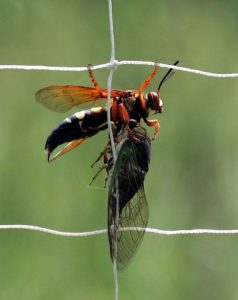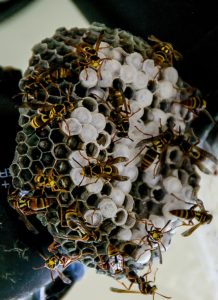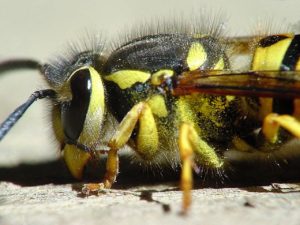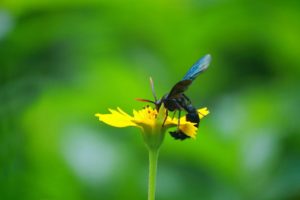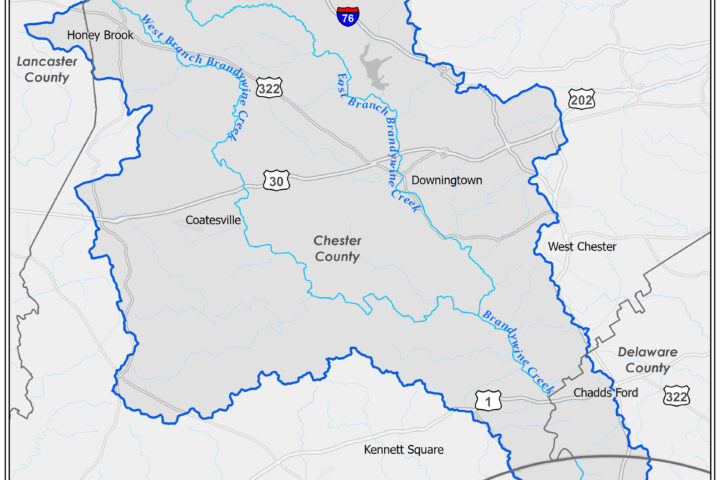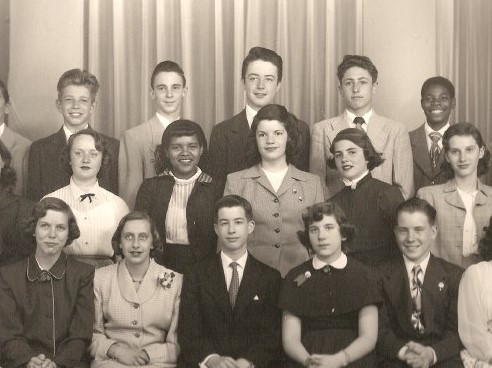As the days become warmer, many insects throughout Pennsylvania emerge. Spring, summer, and fall are some of the busiest times of year for insects and the best times of year for people to come into contact with them. Some of the insects that Pennsylvanians may encounter are stinging insects, such as bees, wasps, and hornets. Most people are familiar with the importance of bees as pollinators, but wasps and hornets also function as pollinators, in addition to managing a number of agricultural and horticultural pests. Check out these wasps and hornets found throughout Pennsylvania!
Similar in appearance to a yellowjacket, bald-faced hornets get their names from their largely black bodies and mostly white faces. Bald-faced hornets are found throughout the US and build aerial nests that can grow to the size of a basketball and that are often found 10-12 feet off the ground.
Bald-faced hornets are an aggressive species of wasp that can deliver a powerful sting if they are provoked or threatened. However, they are also beneficial in that they feed on pests, such as flies.
Resembling a large yellow jacket, cicada killer wasps can grow up to 1 ½ inches long. Sporting a rust-colored red head and middle segments, cicada killer wasps are also identified by their yellow-and-black striped back segment, and their antennae and wings are tinted yellow.
Commonly found in early summer along the edges of forests and gardens, cicada killer wasps can act as pollinators as they feed on flower nectar, but they also feed on cicadas, hence their name. Females are also known to paralyze cicadas in order to lay eggs upon them (one cicada for each egg), therefore cicadas act as hosts for cicada killer wasp larvae. Female cicada killer wasps can sting if threatened, but male cicada killers lack the ability to sting and only behave aggressively when threatened.
Paper wasps are distributed throughout North America and can be identified by their 0.5-1.5 inch long reddish brown or black body, and the striking yellow rings around their abdomens. Paper wasps are often mistaken for bees, but they lack bees’ characteristically fuzzy bodies.
Paper wasps acquired their name from the way that they create paper from chewing wood and vegetation that they then use to make their nests. Cited as resembling an upside-down umbrella held up by a single stalk, these paper nests consist largely of brood cells, or compartments for the queen wasp’s young.
Paper wasps can sting people when their nest is approached or threatened, but they are largely beneficial for gardens, as they are not only pollinators (as they can feed on nectar), but they also hunt pest caterpillars that destroy gardens and crops.
Eastern yellow jackets are a ground-nesting species of wasp that are found throughout the eastern US, spanning a range that expands from the Atlantic Ocean to North Dakota and Texas. Eastern yellow jackets are commonly found in parks, woodlands, lawns, and can even make their nests inside homes. Eastern yellow jackets are identified by their striking black and yellow markings, with a largely yellow face.
Eastern yellow jackets are considered a beneficial insect because they reduce the number of pests, such as earwigs and caterpillars, that can destroy crops. However, eastern yellow jackets can become very aggressive if their nest is disturbed, and can deliver painful stings as a result.
Scoliid wasps (or blue winged wasps) are a ½ inch long wasp found throughout a habitat range that stretches from New England, to Florida, and west to the Rocky Mountains. Scoliid wasps have a black head and thorax, a rusty red-colored abdomen, and two yellow spots that are found upon the first red abdomen segment.
Scoliid wasps act as pollinators as they feed on the nectar of various plants. Female scoliid wasps are also helpful hunters for garden pests such as June and Japanese Beetle grubs, as these grubs act as hosts to scoliid wasps’ eggs. Only stinging when they are threatened, scoliid wasps are generally harmless wasps.
References
Baker, J. (2019, September 11). Blue-winged wasp. NC State Extension. https://content.ces.ncsu.edu/blue-winged-wasp
Barzaga, B. & Gittle, C. (2020). Scolia dubia. Animal Diversity Web. https://animaldiversity.org/accounts/Scolia_dubia/
Big Blue Bug Solutions. (2020). Cicada killer wasps. https://www.bigbluebug.com/pest-identification/profile/cicada-killer-wasps
Cornell Cooperative Extension of Oneida County. (n.d.). Stinging insects: Paper wasps. http://idl.entomology.cornell.edu/wp-content/uploads/Paper-Wasps-CCE.pdf
Home Paramount Pest Control. (2020). Beneficial besties: The Blue-winged wasp. https://www.homeparamount.com/blog/beneficial-besties-bluewinged-wasp
Jacobs, S. (2015, March). Eastern yellowjacket. PennState College of Agricultural Sciences. https://ento.psu.edu/extension/factsheets/eastern-yellowjacket
National Pest Management Association. (2020). Bald-faced hornets. https://www.pestworld.org/pest-guide/stinging-insects/bald-faced-hornets/
Rescue! (2019, August 7). Bald faced bully. https://www.rescue.com/latest-buzz/outdoor-pests/bald-faced-bully/
Sinclair, A. (2016, August 18). Blue winged wasp, Scolia dubia – is a real asset! Penn State Extension. https://extension.psu.edu/blue-winged-wasp-scolia-dubia-is-a-real-asset
Terminix. (2020). 7 facts about paper wasps. https://www.terminix.com/blog/bug-facts/7-facts-about-paper-wasps/



